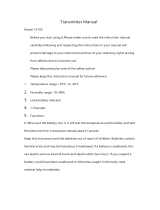
• Be sure the target shape and condition is
appropriate to reflect the laser beam.
• Be sure that nothing, such as leaves or
grass, is between the Laser IRT and the target.
If problems persist after consulting the Troubleshooting Table, please contact your
local dealer to check/repair the Laser IRT. Never let anyone other than the official
representative of the product manufacturer check or repair the Laser IRT. Failure to
follow this instruction could result in injury, or damage to the product.
This device complies with Part 15 of the FCC Rules. Operation is subject to the
following two conditions: (1) This device may not cause harmful interference, and (2)
this device must accept any interference received, including interference that may
cause undesired operation.
This equipment has been tested and found to comply with the limits for a Class B
digital device, pursuant to Part 15 of the FCC Rules. These limits are designed to
provide reasonable protection against harmful interference in a residential
installation. This equipment generates, uses and can radiate radio frequency energy
and, if not installed and used in accordance with the instructions, may cause
harmful interference to radio communications. However, there is no guarantee that
interference will not occur in a particular installation. If this equipment does cause
harmful interference to radio or television reception, which can be determined by
turning the equipment off and on, the user is encouraged to try to correct the
interference by one or more of the following measures:
- Reorient to relocate the receiving antenna.
- Increase the separation between the equipment and receiver.
- Consult the dealer or an experienced radio/TV technician for help.
Do not use the Laser IRT for purposes beyond the limits of its stated accuracy.
CAUTIONS BEFORE USE
Please observe the following guidelines strictly so you can use the equipment
properly and avoid potentially hazardous problems. Before using this product, read
thoroughly the “SAFETY AND OPERATION PRECAUTIONS” and instructions on


















